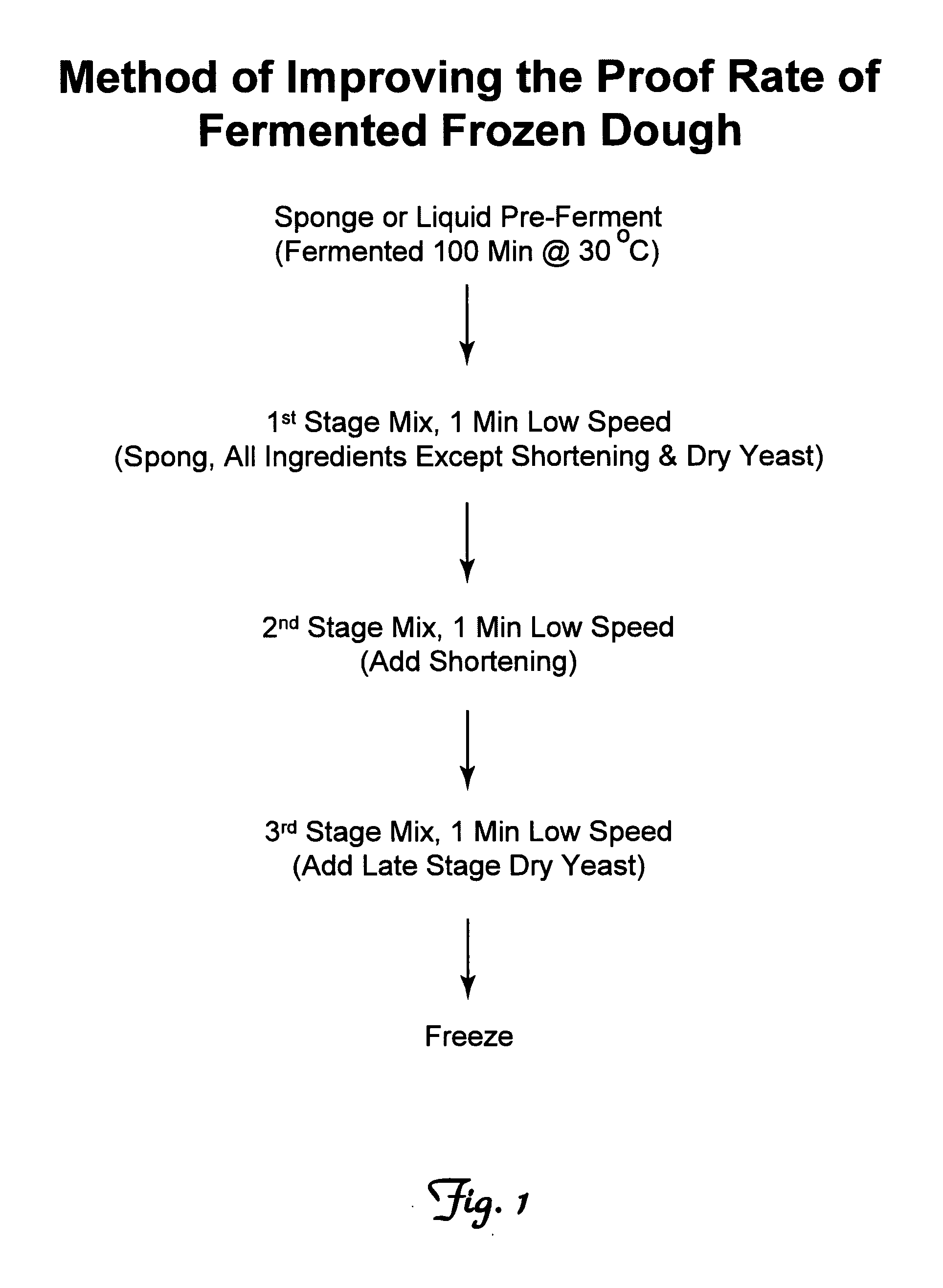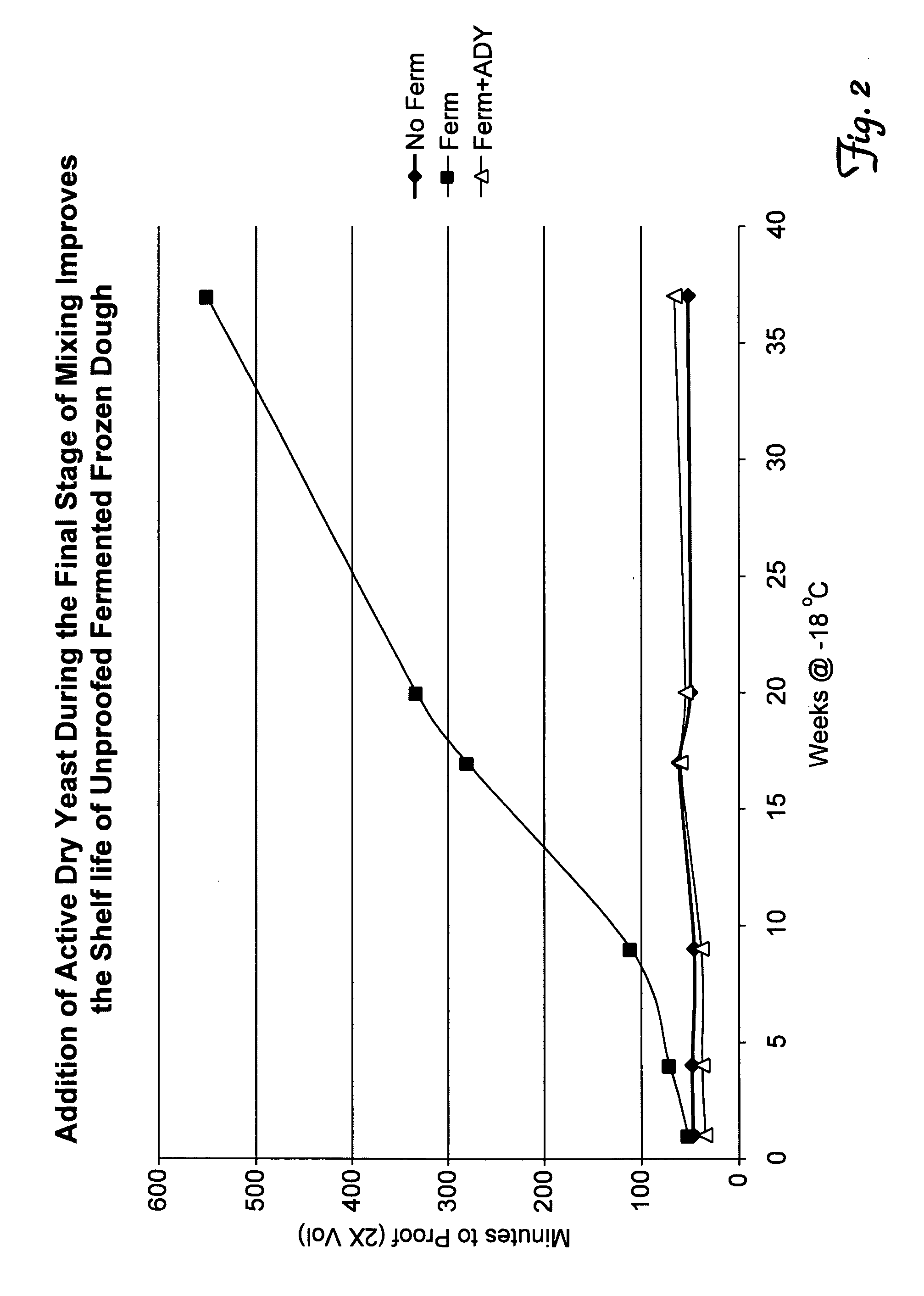[0009] Desired
organoleptic properties can be achieved by allowing yeast in a dough to be active and ferment within the dough, before freezing the dough. For example, many commercial bread doughs include as a step during their manufacturing process of up to 24 hours of
fermentation, e.g., 3 hours for some white bread dough products. One
disadvantage, however, of allowing yeast to become active prior to freezing, can be that the activated yeast can be more susceptible to damage during frozen storage, which can reduce
shelf life of a
resultant dough product by reducing the level of
metabolic activity that the yeast can achieve upon thawing, which reduces the ability of the yeast to become active to proof and leaven a dough after frozen storage. The more active a yeast becomes before freezing, the more susceptible the yeast can become to such adverse effects. Thus, it has previously been taught that limiting yeast activity before freezing can improve performance of yeast in a frozen, unproofed dough, by improving the ability of the yeast to proof the dough upon thawing. Yet there remains the opposing motivation to activate yeast prior to freezing, to produce desired
organoleptic properties.
[0011] An additional portion of yeast (referred to sometimes herein as “later stage” or “
late stage” yeast), in the form of a dry yeast ingredient, is also added to the dough or dough ingredients. The
late stage, dry yeast, is added to a dough composition at a time that prevents at least a portion of the dry yeast from becoming hydrated prior to freezing; i.e., at least a portion of the
late stage dry yeast is non-hydrated at the time of freezing the dough composition. As a result, a dough of the invention includes some amount of non-hydrated yeast at freezing. This yeast, because it has not become hydrated, has not been weakened to become susceptible to damage during freezing, as happens when yeast cells become hydrated and active. This non-hydrated yeast can contribute to desired proofing of the unproofed dough composition upon thawing and prior to baking.
[0014]
Yeast cells and yeast granules can be viewed by microscopic analysis of a dough composition to review whether a yeast ingredient or yeast cells are dispersed or in the form of granules. Granules of yeast cells that can be viewed in a dough composition, wherein the granules have not absorbed water to
hydrate the cells of the granules, include non-hydrated yeast cells.
Yeast cells that can be viewed in a dough composition as granules of agglomerated yeast cells, wherein the granules have been exposed to water for a time that allows the yeast cells of the granules to absorb water to become hydrated (e.g., at least an hour), include hydrated yeast cells.
Yeast cells that can be viewed in a dough composition in a non-granule form (e.g., dislocated from granules by high speed mixing to distribute individual yeast cells throughout a dough composition) normally become hydrated within a short time upon
exposure to the dough composition, e.g., within a short time from becoming separated from a yeast ingredient granule.
[0015] According to the invention, adding dry yeast to a dough composition during preparation, and preventing an amount of that dry yeast from becoming hydrated before the dough composition is frozen, prevents damage to yeast cells that might occur during freezing or frozen storage. Thus, in accordance with the present description and the discussion of non-hydrated and hydrated yeast ingredients and yeast cells, methods of the invention can involve adding dry yeast to a dough composition—e.g., in the form of a yeast ingredient that includes granules of dry yeast cells—during preparation of a dough. The dry yeast can be added at a late stage of preparation, and the dough composition can be frozen before the yeast has enough time to become hydrated, and without exposing the yeast to conditions such as an amount of mixing that would cause the granules of yeast cells to break down and allow individual yeast cells to become dispersed and hydrated. Some amount of the individual cells of a late stage dry yeast may necessarily become hydrated. Still, enough of the individual cells remain non-hydrated to affect proofing properties of the dough composition after freezing, compared to a similar fermented unproofed dough that does not include late stage-added dry yeast.
[0017] One possible effect found to occur according to certain specific embodiments of methods and compositions of the invention can include useful and advantageous frozen stability and
shelf life of a frozen, unproofed, yeast-fermented dough product, including useful proofing properties following extended periods of frozen storage. According to certain embodiments of the invention, an unproofed frozen dough composition can be stored for greater than 2 weeks, greater than 4 weeks, greater than 6 weeks, and even up to or exceeding 10, 20, 30, or 36 weeks at frozen storage (e.g.,—18 degrees Celsius), and can still exhibit useful proofing properties, e.g., the ability to be proofed to double its original volume (after thawing) within a reasonable time following thawing, at a proofing temperature of about 30 degrees Celsius.
 Login to View More
Login to View More  Login to View More
Login to View More 

